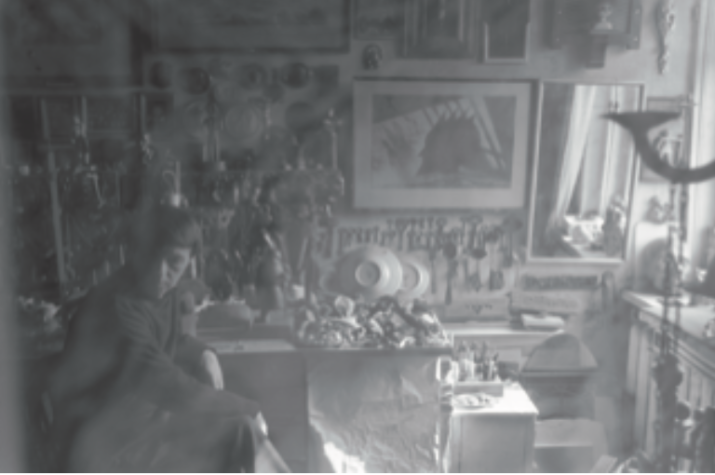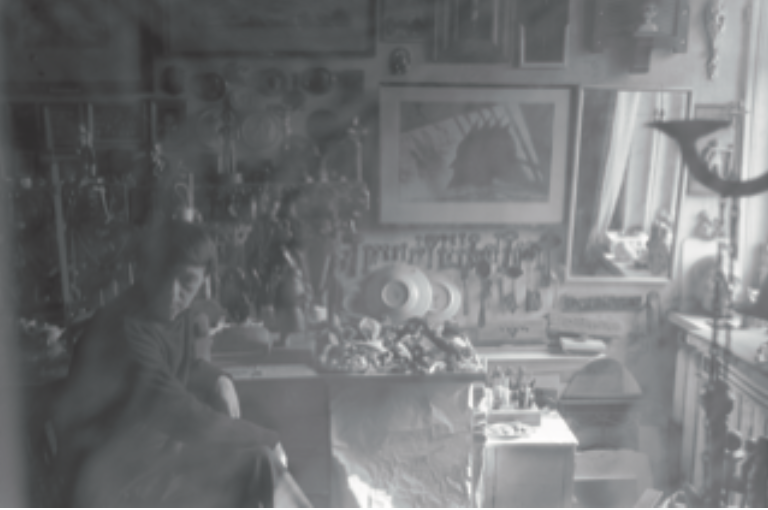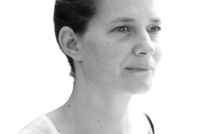
From ‘Trophy’ To ‘Patrimony’: Material Feelings and Proprietary Emotions in Post-WWII Kaliningrad

This is part of our special feature, Displacement, Memory, and Design.
While the fate of the German population displaced in the former East Prussia, today’s Kaliningrad Oblast, has attracted considerable scholarly attention,[1] less is known about the property and personal belongings left behind or “proprietary emotions,”[2] and material feelings of Kaliningrad’s new occupants.’[3] What emotional responses did the forcibly acquired things produce in their new owners? How did these feelings initially form and gradually change, and under which conditions? As a sociologist doing ethnographic research first in 2001-2003 and then again 2015-2016, I discovered distinct sentiments towards homes, household goods, and items of everyday use that people refer to as “German.” Kaliningrad is one of numerous examples of war-time territorial annexation, forcible and voluntary resettlement, and property transfer. Divided between Poland and the Soviet Union, East Prussia, with its capital city Königsberg, experienced a complete population expulsion and new settlement. In summer 1945, the Soviets moved swiftly to implement the war-time and postwar settlement agreed upon by the Allies removing the remaining 120,000 Germans still in the city at the end of the war, while confiscating and redistributing most of their possessions. The jewel of East Prussia, formerly a city of one million Germans, was no more.
This expulsion and property transfer was not only legal (although cases of unsanctioned and punishable plunder are also known) but also emotionally comforting, publicly justified, and personally appreciated by the new residents. There was a remarkable ease with which the state and its citizens redistributed and accepted things taken from their defeated enemy.
If at the end of the war, confiscated homes and personal belongings were appreciated for their material value, with time, the dispossessed objects actually seemed to obtain a certain aura. When I was conducting research, my interlocutors spoke of objects they “inherited” in the formerly German homes, personalizing them and attributing to them certain powers. One retired military nurse who moved to Königsberg in 1946 with the army and received her two-bedroom, fully furnished apartment from the temporary military government, has never moved out of it. Indeed, since 1946, she resisted any attempt by her family to replace the original home furnishings or appliances with more modern versions. She showed me with affectionate tenderness the voluminous sink and the spacious bathtub in the bathroom made of cast iron, and still bearing the stamp of the German manufacturer. She made me touch and enjoy the smoothness of her porcelain door knobs she refused to replace with more contemporary versions. Prompted to speak about the feelings toward her home, the woman invoked the “respectability” that it imparted on her. A businessman in his mid-forties, born and raised in Kaliningrad in what once was a suburban villa allocated by the state to his grandfather, a high-ranking officer in the 1940s, expressed similar pride. He purchased his birth home in 1993, during the housing privatization years, and now restores it meticulously, drawing on archival sources and using original materials. My interlocutors showed me dressers, cardboards, bed frames, plates and cups, picture frames, and tableware. These were all still in good condition, and all of them were also part of a state-sponsored expropriation of property.
The distinct identification of these objects as “German,” makes it clear that their origins have never been in doubt. Indeed, problematic provenance of these objects does not appear to trouble the current owners at all. If anything, the owners have protected these objects, and in the process amplified their symbolic meaning to them. The anthropologist Katherine Verdery argues that ownership is a power-imbued relation that can be organized in a number of cultural idioms to secure control over it.[4] Each idiom—each framing—is not merely cultural or symbolic in the ‘thin’ meaning of the words. It involved powerful institutional players and some of the most fundamental requirements of ontological security. It is mediated at the level of discourse and practice political and quotidian alike.
It is through such idiom, and not the prism of law and jurisprudence, that proprietors make sense of dispossession. In Kaliningrad specifically, the confiscated or dispossessed German items find meaning for their Russian owners through two idioms: “trophy” or “patrimony.” “Trophy” in Russian, like in English, denotes a cup or other decorative object awarded as a prize for a victory or success, as well as a souvenir of an achievement.[5] Both meanings are at play when my respondents refer to some of their home possessions, as trofeinoe. The trophy expresses one’s pride with triumph. A dictionary definition of “patrimony,” expresses a different connotation: it means property inherited from one’s father or male ancestor. It is a corpus of valued things passed down from previous generations.[6] On the emotional plain, it brings out reverence and sentimental reflection. In Kaliningrad, patrimony emphasizes the positive value through an ethic of respect, care and custodianship. “Trophy” and “patrimony” permit different readings of history and social change over time and establish different vectors of international and global connectedness.
The origins and evolution of feelings toward material possessions in Kaliningrad is inseparable from the specific history of property in the Soviet Union. What Kaliningraders experienced towards their new possessions was undoubtedly rooted in the forced nationalization of housing after 1923, the collectivization of industry and agriculture during the Purges, and the concomitant forced population exchanges of the 1930s. All these recent experiences played a significant role in reshaping the norms of ownership away from private property.[7] Most decisive in the context of Kaliningrad was how the newly resettled population came to terms with the belongings they received as a result of the post-WWII international agreements. Negotiations concerning the territorial realignment east of the Curzon line had begun in 1941 and the fate of East Prussia would be sealed by February 1945, officially finalized in the Potsdam Conference in August 1945.[8]Furthermore, the Yalta Conference of 1943 stipulated that reparations to the Allied countries would be expected after Germany’s defeat; paid not in money but material wealth, industrial assets, intellectual property and forced labor. The Soviet government negotiated reparation payments for $10 billion in material assets to be taken from the Eastern territories, the Soviet Zone of Occupation.[9] This international agreement provided a powerful legal framework that ratified subsequent actions by the Soviet military and civilian forces, which resulted in the creation of an institutional network and organizational procedures for carrying out dispossessions.
The requisitions were overseen by a special committee created by the Counsel of People’s Commissars (Sovnarkom), but each individual ministry deployed its own officially designated “trophy battalion.” They were entrusted with dismantling and shipping the equipment and materials to be used or produced for specific enterprises. Some trophy battalions dealt with boats and barges, others with communication cables and telephones, yet others focused on heavy mining machinery, coal, and ore. A network of processing centers was created along the paths of movement where equipment and goods would be temporarily stored and sorted. The efficiency of operations, however, was wanting and procedures and regulations were frequently violated.[10] Control over captured civilian resources and anything left on the battlefield was divided between the military commandant and units responsible for trophy collection, but soldiers and commanders often felt that they had a right to their own trophies.
Dispossession became more acceptable as it became evident that the Soviet Union would win the war.[11] In this context, the permissiveness of the loot “appealed to a much more ancient understanding: to the victor go the spoils.”[12] In the last month of the war, the official position shifted to implicitly inviting soldiers to loot.[13] Archival photos show images of Soviet soldiers in their “victory pose” with “restituted” wrist watches on both arms.[14] The international legal framework and the institutional character of confiscation undoubtedly tuned the proprietary emotions of those who came to resettle East Prussia.
In the unbound lawlessness and unspeakable violence that overwhelmed war-time Europe, the territories which were transferred, ethnically cleansed, and repopulated presented the state with a particular kind of dilemma. For the majority of Soviet soldiers, fighting abroad and taking trophies meant seizing objects and shipping them home to Russia. For those who were deployed in East Prussia or brought in to resettle the region in 1945, the dispossession of the former population implied the making of a new home for themselves. The burden or ethical concerns of this process were undoubtedly eased by the fact that their new homes were the “spoils” of a larger, legitimate postwar settlement to punish Germany and extract reparations for the destruction it had wrought on the Soviet Union. It was this context that enabled the new settlers to “put aside” any sort of deeper reflection, and allowed them to refract these official policies, making them integral to the formation of a new place and an emotional bond to it. It was also how the way was paved towards transforming what had been a “trophy” into an inherited “patrimony.”
Meet Vladimir. Throughout the summer of 2003, he and I talked about his life in Kaliningrad after he was decommissioned in June 1945. Originally from the Smolensk region, he was stationed in East Prussia, near Königsberg, when the war ended. A young man barely twenty years old with no family left other than a sister, he saw no point in going back and he wrote to his sister, Aleksandra, asking her to join him in Königsberg. All he owned was his army backpack. His sister arrived with a bundle containing a change of clothes and a few family photographs. Together, the siblings “bought” a tiny room from someone they called “the Lithuanian”: “five square meters for 300 rubles,” Vladimir recalls. Vladimir now is convinced that the purchase was illegal since housing units were not private property but were instead distributed by the municipality, or in some instances, factories to which they were assigned for workers’ housing. New arrivals did not ask for cadaster or property deeds:
[When we got off the train,] we were put in a horse-pulled cart and rode along different streets. On Telmann Street there were many beautiful vacant homes in good shape, but those were already reserved for Party Committee members. On Gorky Street most houses were bombed out and severely destroyed. It would be impossible to live in them. I didn’t choose anything there. On the way back, we took a turn and I saw a house. I liked it right away. This is where I still live.[15]
The grammar of repossession evaluated buildings’ worth in terms of usability, not ownership rights: How livable was a place? How much effort would fixing it require? How safe did it feel to the new occupants?
Already having a place to live came in handy when in 1946-1947 the new civilian government created a housing registry in Königsberg by issuing official “residency orders”—the documentation that fixed rights of occupancy. Thanks to their de facto living in the room they had obtained, Vladimir and his sister became “sitting tenants,” along with many others who had squatted the city en masse. Possession did not equal ownership.
The room that Vladimir and his sister occupied was part of a communal apartment according to the official typology, meaning that it was shared. But it was also communalized in a very specific way. The siblings’ homemaking went hand in hand with taking apart other people’s former homes, extracting whatever was of use from the heavily damaged city. Vladimir and his sister had to secure each and every piece of their new dwelling themselves, including a new door for their room. For several months, they slept on the floor, one quilted jacket under their head and another as a blanket. The floors were so filthy at first that they had to pour boiling water on them and then scrape off layers of sticky dirt. Soap was scarce and used only for bathing and occasionally for laundry. The same boiling water helped get rid of lice and flees. To make their room hospitable the siblings went scavenging from vacant houses in another part of the city, taking door knobs, bolts, window frames, even wire. More valuable domestic items were becoming rare and harder to scrounge by the winter of 1946. Each element, every detail that could be removed and reused was undone and recycled; if not in one’s own household, it could be traded on the black market. This created a constant circulation of objects that did not stay with one owner. “Once I came home from work,” remembers a participant in the oral history project, “and found I had no door. Someone had unhinged our door and taken it with them. I ran to the neighboring house and took a door I found there. I too unhinged it and brought it home with me.”[16] The interviewee’s casual acceptance of the perpetual coming and going of things in this story is remarkable.
The extremes of poverty notwithstanding, Vladimir and Aleksandra considered themselves lucky. A simple fact of “having their own corner,” as Russians often refer to their home, filled many with joy. “I was so happy, simply ecstatic. All I did was sit in my room looking out the window—my window! My room!” recalled a female interviewee. Her words betray the fragility of home at the time, and consequently her own extreme vulnerability. In actuality nothing, not even a corner was “hers” in the sense of her owning it—yet, nothing could diminish the intensity of her pleasure at having a place to be, a place to make her home. A token of a devastating war, East Prussia was simultaneously a “reparation” and a “home” for thousands of voluntarily and semi-forcefully displaced and resettled people. “Trophy” and “patrimony,” two distinct identities that confiscated properties and belongings historically assumed there, negotiate to this day the emotional impact of a catastrophic war of German aggression that took the lives of fourteen percent of Soviet citizens.
Olga Sezneva is a sociologist, writer and art curator currently teaching at the University of Amsterdam. She dedicated much of her work to unraveling the complexity of history, geography and culture in transferred territories and divided cities. Her writing on forced migration, urban reconstruction and post-war Russia and Europe appeared in Journal of Urban History, Ethnic and Racial Studies, Environment and Planning D: Society and Space and many others.
References
[1] Alexander C.Diener and Joshua Hagen. Borderlines and Borderlands : Political Oddities at the Edge of the Nation-State (Lanham, Md.) 2010. On the subject also see: Gregor Thum, Uprooted : How Breslau Became Wrocław During the Century of Expulsions (Princeton N.J.) 2011; Peter B. Clark, The Death of East Prussia: War and Revenge in Germany’s Easternmost Province. (Andover, Mass.) 2013. A portion of this essay has been published in: Sezneva, Olga. ‘Of Trophy and Triumph: affective lives of dispossessed homes’, in Watson, S. (ed.). 2019, Spatial Justice in the City. London: Routledge, 2019. https://doi.org/10.4324/9781351185790 pp 79-94
[2] Heather Conway and Stannard, John. “Property and Emotions.” Emotion Review 8, no. 1 (January 2016): 38–43.
[3] This essay builds on the discussions held at the workshop ‘Material Feelings: Mass Property Transfers and Emotions in Postwar East/Central Europe’ organized by Kornelia Kończal (Ludwig-Maximilians-Universität München) and Ewa Stańczyk (University of Amsterdam) in May 2019. The workshop explored the emotional dimension of property transfers in the aftermath of World War II and the decades that followed it. It defined and empirically substantiated the emotional states of those, who were on the receiving end of expropriated and redistributed properties. The essay further developed in a dialogue with Cathleen M. Giustino (Auburn University).
[4] Katherine Verdery, The Vanishing Hectare: Property and Value in Postsocialist Transylvania. (Ithaca; London) 2003. P. Charles Hachten’s dissertation “Property Relations and the Economic Organization of Soviet Russia, 1941–48” (PhD diss., University of Chicago, 2005) makes a similar point that it is much more important to look at the practices of using property than the letter of the law.
[5] “trophy.” Merriam-Webster.com. 2019. https://www.merriam-webster.com (15 August 2019).
[6] “patrimony.” Merriam-Webster.com. 2019. https://www.merriam-webster.com (15 August 2019).
[7] As Brandon Schechter describes property in the pre-war Soviet Union, “[m]ost property was considered to be “socialist,” belonging to “the people” or “the state” by the mid-1930s…” and “[p]roperty was a privilege rather than a right, and a tenuous one at that.” Brandon Schechter. “Khoziaistvo and Khoziaeva: The Properties and Proprietors of the Red Army, 1941–45.” Kritika: Explorations in Russian and Eurasian History 18, no. 3 (2017): 487-510. P 490.
[8] Diener, Alexander C., and Hagen, Joshua. Borderlines and Borderlands : Political Oddities at the Edge of the Nation-State (Lanham, Md.) 2010.
[9] Norman M. Naimark, The Russians in Germany : a History of the Soviet Zone of Occupation, 1945-1949. (Cambridge, MA )1995.
[10] Norman M. Naimark, 167-169. For a similar process in Upper Silesia see Gregor Thum.
[11] Brandon Schechter (2019). The Stuff of Soldiers: A History of the Red Army in World War II through Objects. Cornell University Press.
[12] Schechter 2017 p. 507.
[13] Brandon Schechter, The Stuff of Soldiers : A History of the Red Army in World War II through Objects . Cornell University Press, 2019. https://doi.org/10.7591/9781501739804
[14] Norman Naimark, 77.
[15] How housing was distributed is described in one of the oral history interviews by a female settler. East Prussia Through the Eyes of the Soviet Settlers // Vostochnai͡a Prussii͡a glazami Sovetskikh Pereselent͡sev 71.
[16]East Prussia Through the Eyes of the Soviet Settlers // Vostochnai͡a Prussii͡a glazami Sovetskikh Pereselent͡sev , 74.




